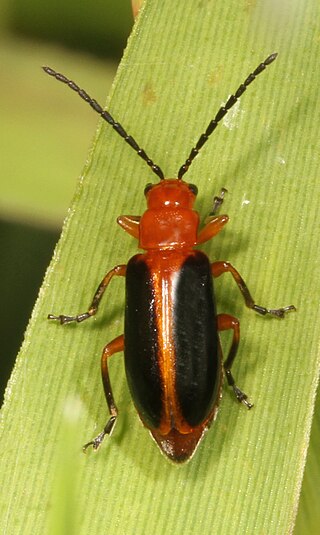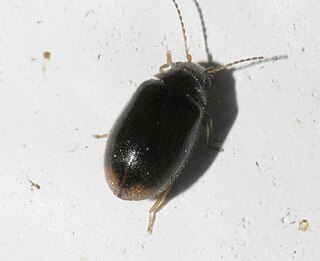
Melanotus is a genus of click beetles in the family Elateridae. There are at least 30 described species in Melanotus.

Scirtidae is a family of beetles (Coleoptera). These beetles are commonly referred to as marsh beetles, as the larvae are typically associated with stagnant water, but can be found in flowing water. Adults prefer decomposing plant material near the water's edge. More than an estimated 600 species are known worldwide, distributed among at least 60 genera.

Brachiacantha is a genus of lady beetles in the family Coccinellidae. There are at least 25 described species in Brachiacantha.

Meloinae is a subfamily of beetles in the family Meloidae. There are at least 330 described species in Meloinae.

Phyllobrotica is a genus of skeletonizing leaf beetles and flea beetles in the family Chrysomelidae. There are at least 18 described species in Phyllobrotica.

Acritini is a tribe of clown beetles in the family Histeridae. There are about 12 genera and at least 250 described species in Acritini.

Abraeinae is a subfamily of clown beetles in the family Histeridae. There are at least 20 genera and at least 440 described species in Abraeinae.

Quedius is a genus of large rove beetles in the family Staphylinidae. There are about 800 described species in Quedius.
Contacyphon americanus is a species of marsh beetle in the family Scirtidae. It is found in North America.

Limonius is a genus of click beetles in the family Elateridae. Many of the species formerly placed in this genus have been removed to other genera such as Gambrinus.

Mycterus is a genus of palm and flower beetles in the family Mycteridae. There are about seven described species in Mycterus.

Ophryastes is a genus of broad-nosed weevils in the family Curculionidae. There are at least 30 described species in Ophryastes.

Limnichidae, commonly called minute marsh-loving beetles, is a family of beetles belonging to Byrrhoidea. There are at least 30 genera and 350 described species in Limnichidae. They are found worldwide, with the greatest diversity in tropical regions. Most species seem to be associated with water-adjacent habitats, such as riparian and coastal locations, though many species are likely fully terrestrial, with some species being associated with leaf litter and arboreal habitats. Species with known diets feed on moss or algae. The oldest fossils of the family are known from mid-Cretaceous Burmese amber from Myanmar.
Contacyphon cooperi is a species of marsh beetle in the family Scirtidae. It is found in North America.

Contacyphon pusillus is a species of marsh beetle in the family Scirtidae. It is found in North America from British Columbia east to Quebec and south to Florida. Contacyphon neopadi was synonymized with C. pusillus and all previously documented occurrences of C. padi in North America are now considered to be this species.
Herthania is a genus of marsh beetles in the family Scirtidae. There are at least seven described species in Herthania.
Contacyphon perplexus is a species of marsh beetle in the family Scirtidae. It is found in North America.
Contacyphon padi is a species of marsh beetle in the family Scirtidae. It is found in Europe and Northern Asia.
Contacyphon variabilis is a species of marsh beetle in the family Scirtidae. It is found in Europe, Northern Asia, and North America.

Hemicyphon is a genus of marsh beetles in the family Scirtidae. There is one described species in Hemicyphon, H. ruficollis, which occurs in eastern North America. The species was previously placed in Exneria and Cyphon. Hemicyphon was originally described as a subgenus of Cyphon by LeConte in 1866.













